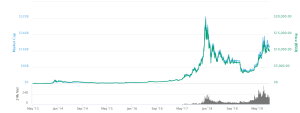Understanding Bitcoin’s Price Volatility
Unravel the mysteries behind Bitcoin’s price swings! This guide breaks down the complex factors influencing Bitcoin’s value, from market sentiment to regulatory changes. Become a Bitcoin price expert!
The price of Bitcoin, a cryptocurrency that has captivated the world’s attention, is notoriously volatile. Its value fluctuates dramatically, influenced by a complex interplay of factors. Understanding these forces is crucial for anyone considering investing in or simply learning about this groundbreaking digital asset. This guide will delve into the intricacies of Bitcoin’s pricing mechanism, examining the key drivers behind its price movements and exploring potential future trends. We will also consider the role of regulation, technological advancements, and overall market sentiment in shaping the price of this digital currency.
Understanding the Volatility of Bitcoin’s Price
Bitcoin’s price volatility is a defining characteristic. Unlike traditional assets with established valuation models, Bitcoin’s value is determined primarily by supply and demand within a relatively nascent and unregulated market. This lack of regulatory oversight contributes significantly to the unpredictable swings in its price. Short-term price spikes and dips are common, often driven by news events, media hype, or changes in investor sentiment. This inherent volatility presents both significant risks and opportunities for investors.
Factors Influencing Bitcoin’s Price
Numerous factors contribute to the ever-changing price of Bitcoin. These can be broadly categorized into macroeconomic conditions, regulatory developments, technological advancements, and market sentiment. Let’s explore each of these in detail.
- Macroeconomic Conditions: Global economic events, such as inflation, recessionary fears, and geopolitical instability, significantly impact investor behavior, influencing the demand for Bitcoin as a potential safe haven asset or a speculative investment.
- Regulatory Developments: Government regulations and policies concerning cryptocurrencies play a crucial role. Positive regulatory frameworks can boost investor confidence, while restrictive measures can dampen enthusiasm and potentially suppress prices. The regulatory landscape varies widely across different jurisdictions, creating further complexity.
- Technological Advancements: Upgrades to the Bitcoin network, such as the implementation of SegWit or the Lightning Network, can influence its efficiency and scalability, potentially impacting its price. Conversely, significant technological setbacks or security breaches could lead to price declines.
- Market Sentiment: Public perception and media coverage of Bitcoin heavily influence its price. Positive media attention and widespread adoption can drive demand and increase prices, while negative news or controversies can trigger sell-offs.
- Adoption Rate: As more businesses and individuals adopt Bitcoin as a form of payment or investment, the demand increases, pushing the price upwards. Conversely, a decrease in adoption can lead to price drops.
The Role of Supply and Demand
Like any asset, Bitcoin’s price is fundamentally governed by the principles of supply and demand. Bitcoin has a finite supply of 21 million coins, a characteristic that contributes to its perceived scarcity and potential for long-term value appreciation. However, the demand side is highly dynamic, fluctuating based on the factors discussed earlier. When demand exceeds supply, the price rises; when supply exceeds demand, the price falls. This basic economic principle is central to understanding Bitcoin’s price fluctuations.
Analyzing Historical Price Trends
Analyzing Bitcoin’s historical price data reveals patterns and trends that can offer insights into its future potential. While past performance doesn’t guarantee future results, studying previous price cycles, bull markets, and bear markets can help investors develop a better understanding of the cryptocurrency’s volatility and potential for growth. Technical analysis, which involves studying price charts and indicators, can also provide valuable insights, although it is important to remember that it’s not an exact science.
The Influence of Institutional Investors
The involvement of institutional investors, such as large corporations and hedge funds, has become increasingly significant in shaping Bitcoin’s price. Their substantial investments can inject liquidity into the market, leading to price increases. Conversely, their decision to divest can trigger significant sell-offs. The entry of institutional investors marks a crucial stage in Bitcoin’s evolution, signaling its increasing acceptance as a legitimate asset class.
The Impact of Mining and Halving Events
Bitcoin mining, the process of verifying and adding transactions to the blockchain, plays a crucial role in maintaining the network’s security and integrity. The reward for miners, who use powerful computers to solve complex mathematical problems, is paid in newly minted Bitcoins. Halving events, which occur approximately every four years, reduce the reward by half, effectively decreasing the rate of new Bitcoin creation. These events often have a significant impact on the price, as the reduced supply can create upward pressure on demand.
Predicting the Future Price of Bitcoin
Predicting the future price of Bitcoin is a challenging, if not impossible, task. The cryptocurrency’s price is subject to so many variables that accurate long-term predictions are difficult to make. However, by considering the factors discussed above and monitoring market trends, investors can formulate informed opinions and manage their risk effectively. It’s crucial to remember that any predictions should be viewed with a degree of skepticism.
Risk Management and Investment Strategies
Investing in Bitcoin carries significant risk due to its inherent volatility. Diversification is crucial to mitigating risk. Investors should only allocate a portion of their portfolio to Bitcoin, ensuring that potential losses won’t severely impact their overall financial situation. Dollar-cost averaging, a strategy that involves investing a fixed amount at regular intervals, can help to reduce the impact of price fluctuations.
- Diversification: Spread your investments across different asset classes to reduce overall portfolio risk.
- Dollar-Cost Averaging (DCA): Invest a fixed amount regularly, regardless of price fluctuations.
- Risk Tolerance: Only invest what you can afford to lose.
- Due Diligence: Thoroughly research before investing in any cryptocurrency.
The Long-Term Outlook for Bitcoin
Despite its volatility, many believe that Bitcoin has long-term potential. Its decentralized nature, limited supply, and growing adoption suggest that it could retain its value and potentially appreciate over time. However, significant challenges remain, including regulatory uncertainty, scalability issues, and the emergence of competing cryptocurrencies. The future of Bitcoin is intertwined with the broader evolution of the cryptocurrency landscape and its acceptance within the global financial system.
Bitcoin’s journey has been marked by periods of explosive growth and sharp corrections. Its price remains highly sensitive to market sentiment, regulatory changes, and technological advancements. While predicting the future price with certainty is impossible, understanding the underlying forces shaping its value is crucial for informed decision-making. The long-term outlook for Bitcoin remains uncertain, but its potential to disrupt traditional financial systems and become a mainstream asset remains a compelling narrative. Further research and a cautious approach are essential for navigating the complexities of this dynamic market. The path ahead is fraught with uncertainty, yet the potential rewards and the ongoing evolution of this groundbreaking technology continue to attract investors and enthusiasts worldwide. Ultimately, the price of Bitcoin will continue to reflect the collective belief and perception of its value within the global market.







